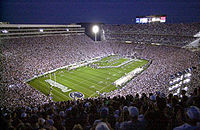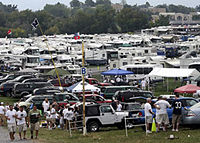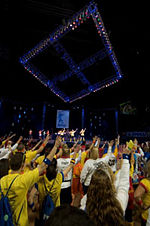Difference between revisions of "Closets of a College Town"
Trunkflare (talk | contribs) m |
Trunkflare (talk | contribs) m |
||
| Line 9: | Line 9: | ||
The generalized 1-in-10 statistic suggests that nearly 4,400 undergraduates at University Park may be lesbian, gay, or bisexual. A 2005 Penn State survey indicated that 79% of students knew of at least one student who was openly LGBT - supporting that the general population is aware of a University LGBT community. Interestingly though, 33% of students had no friends who identified as LGBT and 64% had 2 friends or less who identified as LGBT - indicating that most Penn Staters do not develop a deep connection to the Penn State LGBT community. In the same survey, 69% of students reported being comfortable with individuals who are lesbian, gay, or bisexual and less than half were comfortable with individuals who identified as transgender. These numbers corroborate with the 67% of the general survey takers who thought the University climate was supportive; however, only 33% of LGBT students agreed, indicating that the LGBT community largely has a different experience at Penn State than the general population. <ref name="Pulse1">[http://www.sa.psu.edu/SARA/pulse/136-LGBTA-GISO.pdf] Penn State Pulse. Retrieved 11 April 2010, from <nowiki>http://www.sa.psu.edu/SARA/pulse/136-LGBTA-GISO.pdf.</nowiki></ref><br/> | The generalized 1-in-10 statistic suggests that nearly 4,400 undergraduates at University Park may be lesbian, gay, or bisexual. A 2005 Penn State survey indicated that 79% of students knew of at least one student who was openly LGBT - supporting that the general population is aware of a University LGBT community. Interestingly though, 33% of students had no friends who identified as LGBT and 64% had 2 friends or less who identified as LGBT - indicating that most Penn Staters do not develop a deep connection to the Penn State LGBT community. In the same survey, 69% of students reported being comfortable with individuals who are lesbian, gay, or bisexual and less than half were comfortable with individuals who identified as transgender. These numbers corroborate with the 67% of the general survey takers who thought the University climate was supportive; however, only 33% of LGBT students agreed, indicating that the LGBT community largely has a different experience at Penn State than the general population. <ref name="Pulse1">[http://www.sa.psu.edu/SARA/pulse/136-LGBTA-GISO.pdf] Penn State Pulse. Retrieved 11 April 2010, from <nowiki>http://www.sa.psu.edu/SARA/pulse/136-LGBTA-GISO.pdf.</nowiki></ref><br/> | ||
<br/> | <br/> | ||
| − | The unwelcoming climate experienced by LGBT individuals in the Penn State community causes an all too familiar scenario where closeted students are left fearful and alone. Unfortunately, the same attitude is often resonated throughout the lives of LGBT individuals - for example by their parents, other Penn State parents, or visiting alumni. Fortunately for some closeted students in State College, it is easy to escape oneself and focus on larger and more enjoyable things such as Penn State Pride, football games, Greek life, and excessive drinking. | + | The unwelcoming climate experienced by LGBT individuals in the Penn State community causes an all too familiar scenario where closeted students are left fearful and alone. Unfortunately, the same attitude is often resonated throughout the lives of LGBT individuals - for example by their parents, other Penn State parents, or visiting alumni. Fortunately for some closeted students in State College, it is easy to escape oneself and focus on larger and more enjoyable things such as Penn State Pride, football games, Greek life, and excessive drinking. In addition, with the advent of internet sites, closeted LGBT individuals increasingly turn to sex sites where they can select anonymous sex partners without much risk in outing themselves to family or friends. |
| + | |||
In addition to reducing fear and loneliness, the entertainment offered through these sociable past times may also somewhat counter the national trend for LGBT youth who resort to using harder drugs such as heroin, opiates, and amphetamines. In 2008, University of Pittsburgh researchers reported that LGB youth are, on average, 190% more likely to use illegal substances (including hardcore drugs) as compared to youth who are heterosexual - while those who identify as bisexual and lesbian are nearly 400% more likely to use them. Although there has been no study to delineate drug use specifically among LGBT youth at Penn State, anecdotal evidence and a blanketed study of drug use at Penn State suggest a generally low prevalence of hardcore drugs across the University that may be slightly increased in the Greek system. <ref name="Pulse2">[http://www.sa.psu.edu/SARA/pulse/99-DrugUse.PDF] Penn State Pulse. Retrieved 11 April 2010, from <nowiki>http://www.sa.psu.edu/SARA/pulse/99-DrugUse.PDF.</nowiki></ref><br/> | In addition to reducing fear and loneliness, the entertainment offered through these sociable past times may also somewhat counter the national trend for LGBT youth who resort to using harder drugs such as heroin, opiates, and amphetamines. In 2008, University of Pittsburgh researchers reported that LGB youth are, on average, 190% more likely to use illegal substances (including hardcore drugs) as compared to youth who are heterosexual - while those who identify as bisexual and lesbian are nearly 400% more likely to use them. Although there has been no study to delineate drug use specifically among LGBT youth at Penn State, anecdotal evidence and a blanketed study of drug use at Penn State suggest a generally low prevalence of hardcore drugs across the University that may be slightly increased in the Greek system. <ref name="Pulse2">[http://www.sa.psu.edu/SARA/pulse/99-DrugUse.PDF] Penn State Pulse. Retrieved 11 April 2010, from <nowiki>http://www.sa.psu.edu/SARA/pulse/99-DrugUse.PDF.</nowiki></ref><br/> | ||
Revision as of 15:16, 14 April 2010
Self-Discovery at The Pennsylvania State University
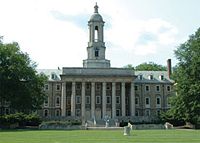
Dear "Old State" is generally held in high regard by its students; not only are they filled with Penn State pride - but moving to the University Park campus gives many people their first opportunity to escape from home and experience the excitement of living on one's own. During college many students embark on the endless path of self-discovery; for example, students may explore their gender identities or sexual orientations. State College is a unique location for such self-exploration, as it has a very large population of athletically-inclined young adults, many of whom are involved with groups that have been typified as homophobic, including a large military program, an impressive Athletics Department, and the second largest Greek system in the country. While Penn Staters who identify with the LGBT community frequently report experiencing harassment or discrimination in situations "lubricated" by alcohol, other places where where anti-gay remarks are commonly reported include military classes, locker rooms, and fraternities or sororities. Given the strong emphasis on Greek life and Athletics at Penn State, behavior observed in these environments intrinsically has a strong influence on the perceived and acceptable social climate around the University.
The generalized 1-in-10 statistic suggests that nearly 4,400 undergraduates at University Park may be lesbian, gay, or bisexual. A 2005 Penn State survey indicated that 79% of students knew of at least one student who was openly LGBT - supporting that the general population is aware of a University LGBT community. Interestingly though, 33% of students had no friends who identified as LGBT and 64% had 2 friends or less who identified as LGBT - indicating that most Penn Staters do not develop a deep connection to the Penn State LGBT community. In the same survey, 69% of students reported being comfortable with individuals who are lesbian, gay, or bisexual and less than half were comfortable with individuals who identified as transgender. These numbers corroborate with the 67% of the general survey takers who thought the University climate was supportive; however, only 33% of LGBT students agreed, indicating that the LGBT community largely has a different experience at Penn State than the general population. [2]
The unwelcoming climate experienced by LGBT individuals in the Penn State community causes an all too familiar scenario where closeted students are left fearful and alone. Unfortunately, the same attitude is often resonated throughout the lives of LGBT individuals - for example by their parents, other Penn State parents, or visiting alumni. Fortunately for some closeted students in State College, it is easy to escape oneself and focus on larger and more enjoyable things such as Penn State Pride, football games, Greek life, and excessive drinking. In addition, with the advent of internet sites, closeted LGBT individuals increasingly turn to sex sites where they can select anonymous sex partners without much risk in outing themselves to family or friends.
In addition to reducing fear and loneliness, the entertainment offered through these sociable past times may also somewhat counter the national trend for LGBT youth who resort to using harder drugs such as heroin, opiates, and amphetamines. In 2008, University of Pittsburgh researchers reported that LGB youth are, on average, 190% more likely to use illegal substances (including hardcore drugs) as compared to youth who are heterosexual - while those who identify as bisexual and lesbian are nearly 400% more likely to use them. Although there has been no study to delineate drug use specifically among LGBT youth at Penn State, anecdotal evidence and a blanketed study of drug use at Penn State suggest a generally low prevalence of hardcore drugs across the University that may be slightly increased in the Greek system. [3]
Athletics and Tailgating
- Example incidents of alcohol-lubricated harassment and discrimination.
- Example incidents of alcohol-lubricated harassment and discrimination.
- ***Disclaimer: Videos may be loud and they contain sexual content, swears, and slurs.***
The following is a short documentary on sexual harassment at Penn State and was completed in 2007 as a project for a Women Studies class. Although the dialogue is specifically centered around sexual harassment, the video is representative of an average Thursday, Friday, or Saturday night in downtown State College. The video includes sexual language and harassment that may be offensive.
- <youtube>WzVYRdyY5rI</youtube>
The next video documents harassment at the Pike (Pi Kappa Alpha) Fraternity after a football game with Ohio State in 2007. The party is representative of an average weekend fraternity party at Penn State. Although the incident centers around school rivalry (and the victims are members of the Ohio State Pike chapter), the assault with full cans of beer and extensive verbal harassment could easily be construed as something more personal. The fraternity was suspended shortly after this incident. The short video contains swears and slurs against gender and sexual orientation that may be offensive.
- <youtube>jDiRPUiQZHc</youtube>
Fraternities and Sororities
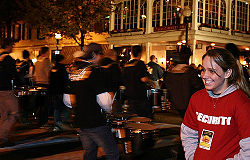
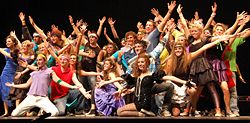
Intersections with LGBTQA Communities
References and Sources
- ↑ Attributed to: George Chriss. "Old Main Building 2006." Photo. 7 July 2006. Creative Commons Attribution ShareAlike 3.0. Retrieved 18 February 2010, from http://commons.wikimedia.org/wiki/File:Penn_state_old_main_summer.jpg.
- ↑ [1] Penn State Pulse. Retrieved 11 April 2010, from http://www.sa.psu.edu/SARA/pulse/136-LGBTA-GISO.pdf.
- ↑ [2] Penn State Pulse. Retrieved 11 April 2010, from http://www.sa.psu.edu/SARA/pulse/99-DrugUse.PDF.
- ↑ Attributed to: Rick Zhuang. "Homecoming Parade 2005." Photo. 28 October 2005. Creative Commons Attribution ShareAlike 3.0. Retrieved 4 March 2010, from http://farm1.static.flickr.com/32/57087024_766d9bc60d.jpg.
- ↑ Attributed to: Tina Hay. "Greek Sing 2009." Photo. The Penn Stater Magazine. 2 November 2009. Retrieved 4 March 2010, from http://pennstatermag.com/category/campus-events/
Contact Information
Name: Eric V. Patridge, Ph.D.
Email: eric.patridge@gmail.com
<comments />
